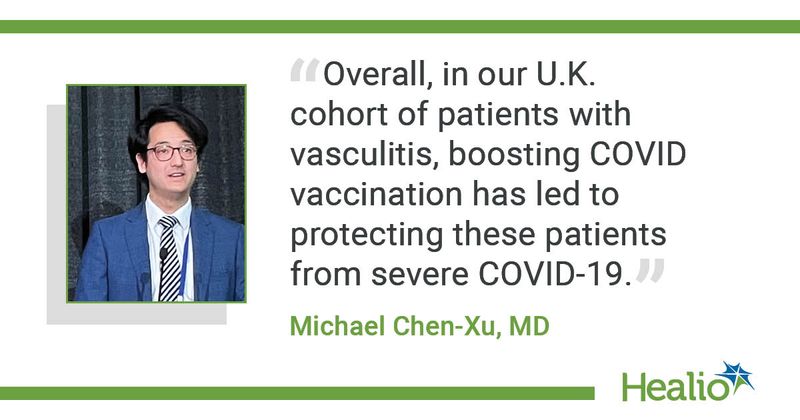Booster COVID-19 vaccine dose protects against breakthrough infection in vasculitis
SAN DIEGO — Patients with primary systemic vasculitis who received a third or additional doses of a COVID-19 vaccine demonstrated a reduced risk for breakthrough infection, according to data presented at ACR Convergence 2023.
“We know immunosuppression is a very important part of the management of patients with primary systemic vasculitis,” Michael Chen-Xu, MD, of theUniversity of Cambridge, in the United Kingdom, told attendees. “However, we know these patients are at high risk for contracting COVID-19. Also, we know that vaccine responses, particularly humoral responses, in patients who are receiving B-cell depleting agents or anti-proliferative agents, are significantly worse.”

It was in this context that Chen-Xu and colleagues sought to answer two key questions.
“We wanted to know how effective these vaccines have been,” he said. “We also wanted to know what are the risk factors for COVID-19 infection in this group of patients.”
To address these questions, Chen-Xu and colleagues enrolled 239 patients with primary systemic vasculitis who had received two doses of a COVID-19 vaccine between Jan. 2, 2021, and April 1, 2023. The multicenter observational cohort study excluded those with previous documented COVID-19 infection. A first confirmed symptomatic breakthrough infection more than 14 days after the second vaccine dose served as the primary endpoint.
The cohort was 48.5% men, with a median age of 58.8 years. The majority of patients had ANCA-associated vasculitis. The median follow-up duration was 400 days (range, 78-756).
According to the researchers, 49% of the cohort experienced a first COVID-19 infection, representing a crude incidence rate of 12 per 10,000 person-days. Fourteen patients required inpatient hospital admission. Two of these patients were admitted to intensive care. There was one fatality associated with COVID-19 infection.
The median duration between second vaccination and first breakthrough infection was 35 days (interquartile range, 285-442). Adjusted demonstrated that seroconversion reduced the likelihood of breakthrough infection (HR = 0.48; P = .012), as did receiving a booster dose (HR = 0.43; P < .001).
“The key finding is that those who had seroconverted with subsequent doses of vaccine were associated with reduction in subsequent COVID-19 infection,” Chen-Xu said.
In addition, chronic kidney disease also reduced the likelihood of breakthrough infection (P = .01), while a history of malignancy (P = .033) and the presence of IgA vasculitis (P = .002) and large vessel vasculitis (P = .009) increased the risk for breakthrough SARS-CoV-2 infection.
“Overall, in our U.K. cohort of patients with vasculitis, boosting COVID vaccination has led to protecting these patients from severe COVID-19,” Chen-Xu said.

